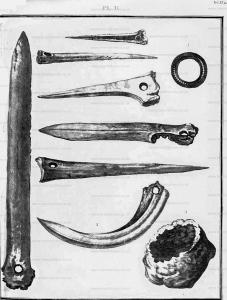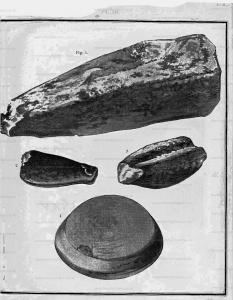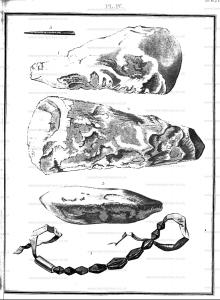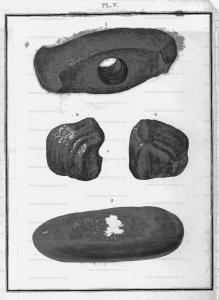Archaeologia Volume 15 Section XI Page 122
Archaeologia Volume 15 Section XI Page 122 is in Archaeologia Volume 15.
Account of Tumuli opened in Wiltshire, in three Letters from Mr. William Cunnington to Aylmer Bourke Lambert, Esq. F.R.S. and F.A.S. Communicated by Mr. Lambert.
Read Dec. 1st, 1803.
Sir, Heytesbury, May 31, 1802
The numerous tumuli or barrows, that meet the eye of the traveller in every direction, as he passes over the Wiltshire. and Dorsetshire Downs; naturally excite the curious mind to know the history of these ancient and simple monuments.
Stukeley, Borlase, and other able antiquaries, [a] have. written much on these subjects, and we have many accounts of casual discoveries in barrows; but it rarely happens that the latter details are marked with that accuracy which, is necessary to elucidate a history, of which (with all our lights) we know, but little; for I am of opinion, that on viewing a barrow, our best antiquaries are not able to ascertain the particular contents, with any degree of certainty; much less to fay in what æra, or by what people it was raised. These reflections have led me to employ many of my leisure hours, in opening a considerable number of the barrows on the Wiltshire Downs, in hopes of meeting with something that might supersede conjecture; such as inscriptions or ornaments on the urns, instruments of war, or perhaps coins, or some discriminate marks to aid the judgment. With the result of some of these researches, you are already acquainted, and I now hasten to give you the particulars of a very interesting barrow which I opened a few days since, on Upten-Lovel Downs near this place. This barrow is situated on an elevated part of the Downs, about a quarter of a mile south of the second milestone, on the road leading from this place to Amesbury: it is of a circular form, forty feet in diameter, very fat, with a little depression near the centre, and in elevation not more than 15 or 28 inches above the adjoining soil. I opened it by a trench of considerable length and breadth; near the centre, at the depth of nearly three feet, we found a skeleton, lying on its back with the head to the north; on clearing away the earth, we discovered another in a fitting posture; the head and bands of which were within ten or twelve inches of the surface. The first appeared, from the largeness of the bones, to have been the skeleton of a stout man; the latter being much smaller, I conjectured might have been a female, perhaps his wife: the bones of both were much decayed, though the teeth were found, and from their appearance indicated no great age. The cist in which they were interred was nearly of an oval form, excepting a small variation to the left of the larger skeleton to make room for the other body; I therefore consldered the latter as a subsequent interment. On removing the earth from the feet of the largest, we found more than three dozen of bone instruments, and as I conceive, arrow and lance heads, [b] some of which you will find delineated in plate II; adjoining to these lay nearly together, three stone or flint celts, fig. 1 , 2, 3, plate IV, also the stones, fig. 1, 2, 3, in plate III, and fig. 2 and 3, in plate V; on clearing the earth from the legs were found several boar’s teeth, these were perforated, see fig 2, plate II, also several eagle-stones of white flint, which have been cut or broke in two, see fig. 3, plate II. Near the breast of this fkeleton we found a stone celt or battle ax, see fig. 1, plate V, also a circular sone, fig. 4, plate III, with about two dozen more of the bone arrow and lance heads: after discovering the latter, a considerable quantity of the bones of the small skeleton fell upon the large one, so that it was difficult to say to which the ring, fig. 1, plate II, belonged ; as also the beads fig. 4, plate IV, which lay together. In delineating the articles, my friend Mr. Crocker has given the sizes and original colours as nearly as possible. The celts are of white flint, fig. 1 and 3 ; are neatly polished, and have a fine circular edge; fig. 2 is only chipped to the intended form and size: the only one that I recollect having seen noticed like these, is described by Borlase, [c] which is of white flint, and very much like fig. 3, but of this you will perceive there is only a side view, (plate V, fig. 1.) The stone celt or battle ax was formed from a very hard stone [d] or pebble, and is most neatly polished, as are the fragments of another, fig. 2, 2, in the same plate ; the stone, fig 3, on this plate was, perhaps, intended for a similar weapon. The long stone, fig. 1, plate III, appears to be of granite or moor-stone, but for what purpose I am at a loss to say, unless to polish the celts or similar instruments. I conceive the small stone, fig. 3 on the same plate, (which is a hard green sand-stone) to have been used for the purpose of whetting to a point the arrow heads. But I am quite at a loss to conceive for what purpose the circular stone, fig. 4, plate III, was used [e] ; it weighs thirteen ounces avoirdupoise; and appears to be made from a light coloured pebble, it is also very neatly polished; I consider the ring to have been worn as an amulet, perhaps the anguinum; it is made of a black substance like canal-coal, it is very light, and has a good polish: from the notches cut on the outside, it appears like a serpent curled up ; the inside has a sharp edge, therefore could not have been worn on the finger, (plate IV.) The black beads are of a similar subftance, the light-coloured one is of ivory or bone. I am also at a loss to find the use of the rough cups formed from the eagle-stones of flint, fig. 3, plate II.; there were five of them with a handful of small pebbles of different colours lying together. Besides the articles already noticed, there were several pebbles and other stones not to be found in this neighbourhood; and also a small brass pin, see fig. 5, plate IV, which is the exact fize of it. On a view of the relicks contained in this barrow, every thing we see indicates a remote period ; probably before either brass or iron arms were in use in this island, or if arms of the former metal were at all in use, they were only to be found in the possession of the great chieftains; we may therefore not err much, if we pronounce this barrow to be an early Celtic sepulchre.
I am, Sir,
Your most faithful Servant,
William Cunnington.
Note a. Mr. Douglas, in his Nenia, has given a very interesting account of the contents of a great many barrows, which he has illustrated, with many elegant drawings. But these tumuli are, with a few exceptions, on the Downs in Kent; and appear to have been the burial places of a distinct people, and posterior to those found in Wiltshire, Hampshire, and Dorsetshire.
Note b. I confess I am almost at a loss to appropriate these stone instruments to any other use; yet the thickness of the ends, which are perforated, at first sight operates against their having been used for that purpose, as also against their use as needles. I think it probable the holes were made for the convenience of stringing them, and a rough stone acting as a file would soon reduce the large end, to a proper size for the head of an arrow or lance. There were three of a more delicate form, that appeared to have been used as needles, but these were broken in pieces.
Antiq. Cornw. 2d ed. page 316, he gives a drawing of a flint celt found in Cornwall, which is very similar to fig. 3, but this was not found in a barrow. Montfaucon Vol, V. gives figures of two flint celts like the above; these latter I believe were found in a tumulus, but I have no recollection of any having been found in the barrows in this country.
Note d. It is veined a little like Purbeck marble.
Note e. I have since seen a similar stone in a sling, which was brought from one of the Sandwich islands. W.C.



